
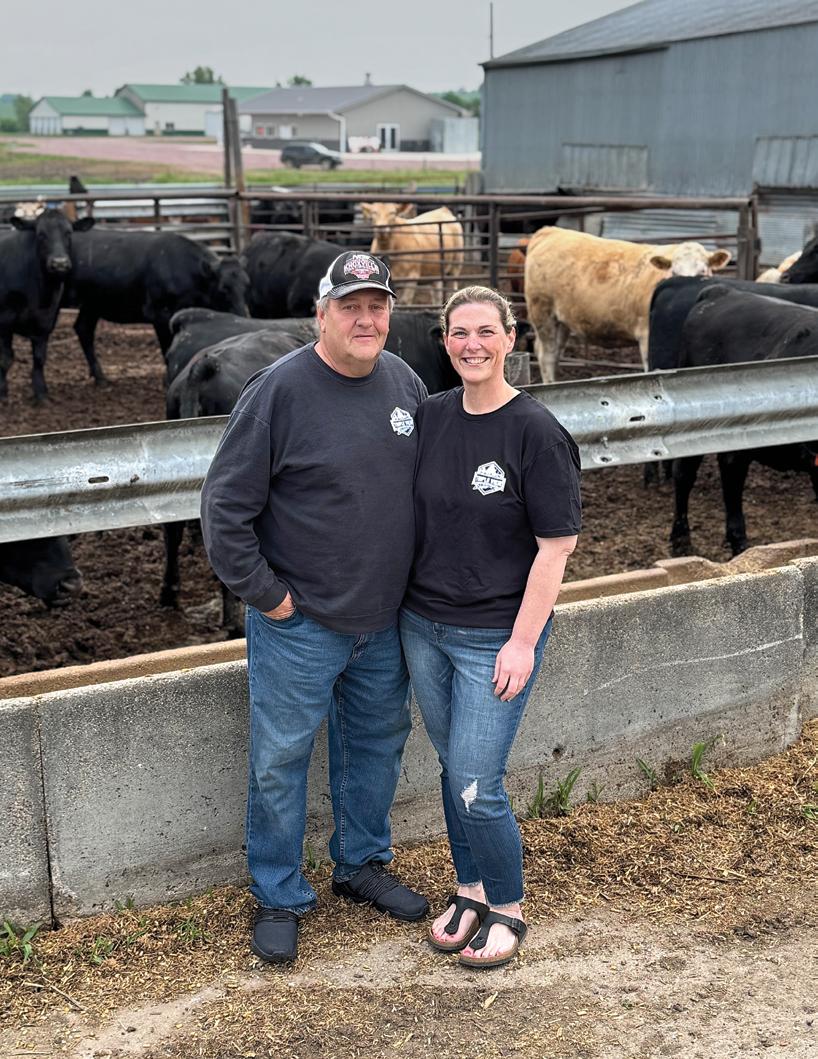













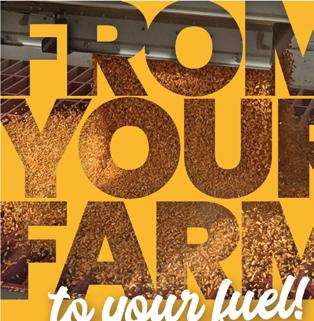




and Mindy Gross, AGE Media
Fitch, AGE Media
advertising inquiries, story submissions and other correspondence to:










The Farming Families is distributed free exclusively to the farmers, ranchers and producers in rural Sioux, Plymouth and Lyon Counties. All rights reserved. Content in this magazine should not be copied in any way without the written permission of the publisher. The Farming Families assumes no responsibility for unsolicited manuscripts or photographs. Content in articles, editorial and advertisements are not necessarily endorsed by The Farming Families and Age Media & Promotion.



By Bob Fitch
Mark Gross grew up on his parents’ dairy farm just outside of Little Rock. In the summertime, after his chores were done, he often jumped on the banana seat of the little yellow bike his grandpa won for him at the Corn Show. He pedaled his way down the gravel and a half mile west on the blacktop to the Little Rock Drive-in, where his older sister, Kathy, was a car hop. Mark passed a nickel across the counter to get an ice cream cone.
Crossing back-and-forth across Highway 9 was always an adventure, especially back then when state highways in Iowa still had a lip on the edge. Friends ask him why he’d so often risk both his neck and the wrath of his mom. His reply: “The ice cream was well worth it.”
He put that motto over the door when he opened Triple View Drivein in the fall of 2023.
Owning a drive-in was a life-long dream for Mark. Family and friends discouraged him from pursuing the dream, saying he already had enough on his plate. Left alone for a couple days in 2023, he had a big slab of cement poured on the north edge of his farm along Highway 9. He didn’t have a blueprint in hand, but pouring the concrete forced the issue of whether or not the dream was on its way to fulfillment.
Now midway through the second full year of operations, he has no regrets. While Triple View has a traditional menu – burgers, fries, grilled chicken, pork tenderloin and other drive-in staples – part of what sets the business apart is that all the beef and pork on the menu is harvested from cattle and hogs he feeds at Triple View Farms. The meat is processed locally at The Cut Meat Market in Sanborn. In addition to its place on the menu, Mark’s fresh-frozen meat products are sold within the restaurant for customers to take locally-grown meat home. In a very short time, he’s built a loyal following for their pork and beef patties, brats, brisket, bacon, Boston butts, sausage, chops and ribeyes.
According to his long-time girlfriend,

Becca Whitacre, “The big thing with the farm-to-table concept is the pride Mark has in raising the cattle and hogs. He feeds them every day. He cares for their health. He plants the corn and harvests the silage the cattle eat.” He said farmers only make up about 2 percent of the workforce in the U.S., yet feed people all over the country and all over the world.

“We
should pride ourselves on the products we produce.”
Even though the day-to-day menu is a traditional one, their specials help keep the locals coming back. Rotating specials such as the hot beef sandwich, steak sandwich and chicken fried steak are very popular.

Providing Feed and Vet Supplies for over 30 years. We also provide consulting services for feedlot cattle and cow calf pairs.
















Left: Ice cream is a hit with all ages. Above: The yellow bike Mark Gross used to ride from the family farm to the old drivein of his youth. Right: Hot beef sandwiches are one of the favorites on the menu. The beef and pork used in the menu comes from animals Mark Gross feeds.
Photos from Facebook page of Triple View Drive-in



















Even with the emphasis on good tasting, locally-grown beef and pork, the Triple View team holds true to Mark’s childhood motto of: “The ice cream was well worth it.” All the typical favorites are on the menu: Vanilla ice cream cones, hot fudge sundaes and “Tornadoes,” (soft serve with candy bar pieces or other treats mixed in). Patrons will also discover old-time favorites not found on a lot of menus anymore, namely root beer floats and real malts (in addition to shakes).
Other surprises include a regularly changing menu of twist flavors. Vanilla is frequently twisted with black raspberry or black raspberry cheesecake (local favorites, especially among the senior set). Among the other flavors rotated in are strawberry, orange creamsicle and chocolate. Don’t be surprised to find Tornadoes that include real banana cream pie and real cherry cheesecake. One of the most popular promotions was Tornadoes with cereal mixed in. Sugared cereal like Lucky Charms, Trix, Cap’n Crunch, Reese’s Puffs or Fruity Pebbles. stay surprisingly crispy in the ice cream. Custom orders for ice cream cakes and specialty pies and cakes are available, usually on a seasonal basis. And who ever heard of this one: Apple pie potstickers with vanilla ice cream and caramel sauce! Triple View customers never know what surprises will appear.
Decades of watching the traffic on Highway 9 convinced Mark that a new drive-in would succeed. “I am dead center on the route between Sioux Falls and Okoboji … it’s 38 miles each way. I am catching travelers coming and going.” The boat and camper traffic flowing from Sioux Falls starts moving eastward on Thursday afternoons. All that traffic flows back west on Sundays from morning until night. The vacation traffic is part of the reason the hours at Triple View extend from 10 a.m. to 10 p.m., seven days a week. (The drive-in is closed from mid-November until April.)
In addition, Mark said, “Sanford and Avera are some of my best friends. It seems everybody from Estherville, Spencer, Spirit Lake, Lake Park and all points east have medical appointments in Sioux Falls. When they go home, they want to quickly get out of the hustle and bustle of Sioux Falls. We’re a perfect place to stop on the way home.”
Triple View Drive-in also acts as a magnet, drawing teen workers from five towns: Little Rock, George, Sibley, Rock Rapids and Doon. The warnings received about not being able to find enough good employees proved to be a false flag. Becca said, “A lot of times, this is their first job. The kids spend a lot of time learning, but we’ve found them to be respectful and professional.” Mark added, “We are very proud of our help. I love to hear the teenagers say, ‘Yeah, I'm not broke anymore.’”
The business has progressed very quickly in less than two years, but it is not all-consuming for Mark’s family. He is

We know the future of our food supply is in good hands with local farmers. It’s an honor to serve you with comprehensive insurance coverage. Trust in Tomorrow.®

fulltime on the farm and Becca is a registered nurse. Her daughter, Kara, is 16 and will be a junior at George Little Rock High School.
She works part-time at Triple View. Mark’s daughter, Taylor, 22, custom-feeds two barns of hogs. “She’s doing very well and I’m very
proud of her,” said Mark. Taylor helps at the drive-in during a pinch.
Ice cream and meat sales aside, Mark is and always will be a livestock feeder, first and foremost. He’s been feeding cattle since the late 1980s. He has a small stock cow herd; feeds out those calves; and buys in feeder cattle to finish. The pork products sold at the drive-in are from hogs he feeds in outdoor facilities. In his list of priorities, field work is kind of a necessary evil since he needs the silage to feed his cattle. He also hires out to haul manure.
Even with all the time the farm requires, he likes telling the farmto-table story. Near the end of the school year, he did a presentation for third graders in Sibley. The class was doing a unit on agriculture and wanted to learn more through









a real-life example. Mark talked about the livestock production process and then how the animals are processed and how he sells the resulting meat products. He said, “We served 55 cups of ice cream afterwards, so that was a lot of fun. I get excited to see the kids smile.”
Small moments stand out to Mark. “One day there was a newborn baby here and there was also a 102-year-old lady. There was no relation between the two, but I thought it was special we were serving customers in such a big age range. I had to get them together for a photo. It was also great to have an assisted living group in here from Sheldon. I enjoyed visiting with them. We feel very blessed.”







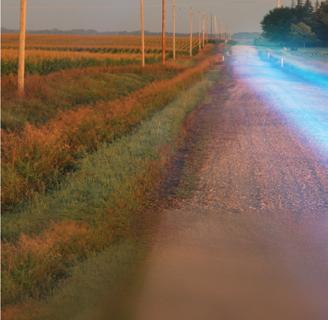









By Bob Fitch
Whether it’s restoring part of a pasture to its prairie beginnings or trying to bring a scene of pre-1840 Iowa into a home landscape, patience is very much a virtue for anyone interested in native plants.
Establishing a strong stand of native plantings adheres to the formula of “the first year you weep (or the plants sleep), the second year you creep, and the third year you leap,” according to Troy and Sarah Davelaar of Rock Valley, who operate Siouxland Prairie Farms LLC. The slow-growth approach also applies to the progression of a native plant nursery and habitat management company.
Troy and Sarah met in 2012 at Dordt University. Troy majored in environmental studies and Sarah majored in biology with an environmental emphasis. Troy became fascinated with propagating native plants and the interaction of those plants with native insects, who pollinate the plants both humans and agriculture rely upon. When the pandemic of 2020 freed up a little time from their full-time
careers, studying the native plant-insect relationship became their hobby.
Troy and Sarah typically collect native seed after reaching agreements with private landowners who have remnant prairie. Collecting seed is painstaking and the couple feels fortunate that extended family and friends help on collection days.
To replicate nature’s processing of seed, Davelaars have to refrigerate some seed for 90 days; or others need to soaked or boiled or steamed or cut with a knife. “It’s really a miracle that each species grows naturally. It’s amazing and it’s incredibly complicated. But the original ecosystem is perfectly designed,” said Troy.
Sarah agreed. “There’s one seed

where there’s an extra protein on the outside of it. Ants like that protein. So the ants haul the seed back to their home, essentially spreading the seed; then they eat the protein off the outside and the seed is left to grow. Now, how
do you mimic an ant? The idea of plants being intertwined with the emergence, migrations and life cycles of insects is fascinating.”
While establishment is slow, most native plants grow well in moist or
Davelaar continued on page 18



FEED & ANIMAL NUTRITION
Specializing in top-quality nutrition so your livestock thrive. Our specialists are your trusted partners for achieving optimal animal performance:
Swine Specialist Nic Smit. 712-395-2600
Beef Specialist Eric Ochsendorf. 712-348-2582
Beef Specialist Hunter Koolstra. 712-470-4267
Dairy Calf & Heifer Specialist Calissa Keller. 507-360-2746
Dairy Cow & Goat Specialist Ed Jumbeck. 712-470-5473




Many plants native to our region can be found in state parks and preserves.
here is

even “crummy” soil. Troy suggested adding organic material to heavy clay soil. Don’t overfertilize – the weeds will like the fertilizer more than the native plants do. Another tip: Don’t do cleanup of your native garden in the fall. “Most native plant stems are hollow, providing a place for bees, wasps and other beneficial insects to lay their eggs. Even though the plant is dormant, there’s still a lot of beneficial life going on in there,” Sarah said. Native grass also provides winter visual interest and cover for native birds. Wait until temperatures are consistently above 55 degrees in the spring to clean up native gardens.
2025 marks five years of the couple’s exploration and effort; and their third year having a greenhouse. The greenhouse helps stretch the growing season, allowing them to get started earlier in the spring and work longer into the fall. Davelaars live in Rock Valley and their greenhouse is located on the farm of Sarah’s uncle. The couple hopes to someday have their own farm with space to expand their seedbeds beyond what their backyard handles now.

Troy said plant buyers have included owners of both residential and commercial properties; plus landowners looking to do habitat restoration. Sarah said, “Oftentimes with homeowners, people are interested in providing food that may attract certain butterflies such as monarch or swallowtail; or diversifying the insect life in their yard. Native plants can do that, plus you can have something blooming from the end of April all the way through October.”
In addition to the plant production, the Davelaars are expanding into garden design and installation, plus larger scale habitat restoration projects. Siouxland Prairie Farms grows 65 different native species. Some of the most popular are wild Bergamot, butterfly milkweed, the Liatris family (four varieties of Blazing Star), Golden Alexander and narrow leaf coneflower.
While typical home and park gardens have innate value in being beautiful, Davelaars’ mindset is that gardens are best planted with species other than humans in mind. “We think our primary consumer is native and local wildlife, as in butterflies and birds. That’s really where our hearts are. We’re doing our little part to shift that mindset to reflect the value of stewardship



of God’s creation as the primary goal,” he said. “At the same time, we say ‘Don’t let perfect be the enemy of the good.’ Every little change makes a difference in the long run.” Sarah added, “Pretty flowers are great, but a pretty flower with a butterfly on it is even better.”
Operating Siouxland Prairie Farms is an evening and weekend enterprise of passion. Both Troy and Sarah have environmentrelated careers serving sectors of the public.
For the last nine years, Sarah has been a naturalist/ environmental educator for the Sioux County Conservation Board, based at Oak Grove Park. She’s loved every minute of serving the public and the camaraderie she shares with her co-workers. The SCCB team provides an extensive selection of programs for toddlers up through senior citizens. The Prairie Woods Nature Center provides Interactive exhibits and information on different habitats including wetland, prairie, forest, as well as covering Sioux County’s geology and settlement history.
On any given day in April and May, SCCB may host from 15 to 120 kids for nature-based field trips at Oak Grove Park. The summer includes many different age-grouped camp programs on everything from budding naturalist, fishing, underground treasures, nature up close and wilderness survival. In the

B&B Gates & Supply carries necessities to have around the farm and various items for your hog barn including heater parts, motors, fan blades, waterline fittings, and so much more. Our service department is also on-call 24-7 and can install new equipment or repair your existing equipment.


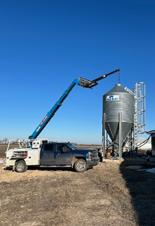


Native gardening tip: Do not clean out gardens until spring. “Most native plant stems are hollow, providing a place for bees, wasps and other beneficial insects to lay their eggs. Even though the plant is dormant, there’s still a lot of beneficial life going on in there,” Sarah said.
fall, nature tours resume right away. As soon as outdoor tour season is done, Sarah and the other naturalists hit the road taking environmental education to schools, nursing homes, civic groups, churches, scouts, homeschools and others. An environmental educator can do as many as nine programs in a single day.
SCCB also presents public programs and events … everything from concerts to fishing clinics to canoeing and kayaking to archery. While many programs are at Prairie Woods Nature Center, some are at Sandy Hollow near Sioux Center, Rivers Bend Campground and the Gun Club in Rock Valley, and local libraries. SCCB manages five campgrounds and 20 wildlife areas in Sioux County.
With the birth of their second child expected in July, Sarah has just moved into a part-time position as a




























conservation department assistant. She’ll help in every department as needed. Their new baby will be greeted at their home in Rock Valley by older brother, Mason, 2½.
After college, Troy first worked as a wildlife biologist with Pheasants Forever, covering four northwest Iowa counties. Five years ago, he joined the USDA-Natural Resource Conservation Service (NRCS) as district conservationist overseeing Lyon County.
“NRCS helps farmers implement conservation practices, to basically steward the land,” said Troy. “One thing I learned at Dordt is the importance of a conservation ethic. My grandpa and uncle own a dairy farm outside of Inwood; and my dad is a feed salesman. So I understand the importance of agriculture. I feel blessed that my passion falls where conservation and agriculture can tie together.”
NRCS personnel help landowners assess resource concerns owners may have on their property. Then they help them identify solutions, resources and potential cost assistance.
“We don’t tell people what to do, which is one of the things I love about my job. When requested, we help people identity and treat resource concerns on their farms. A lot of our job is in field management; helping farmers switch from conventional tillage to no till or strip till, or implementing cover crops. NRCS also helps on structural practices, such as waterways, terraces and basins.” He also helps farmers on the technical side of the Conservation Reserve Program, which is the primary habitat source in northwest Iowa. CRP compensates farmers/landowners for taking acres out of production to plant it into permanent or semipermanent habitat.
• www.nrcs.usda.gov
• www.siouxcountyparks.org
• www.siouxlandprairiefarms.com
Farmers spend more time under the sun than most. That means higher risk of sun damage, skin cancer, and premature aging.
Sun protection can lower your risk of getting melanoma:





The 1890s and the first decade of the 1900s were boom years for Sioux City, Hawarden and much of northwest Iowa. The route from Sioux City to Hawarden was an important rail connection, but the railroad tracks in Akron flooded quite often. Consequently, the Chicago & Northwestern Railroad began building the “Hawarden-Merrill cutoff” in 1909. A stop was needed every seven miles, leading to the establishment of Brunsville, Craig and McNally. Brunsville hit the ground running in 1910. The Le Mars Sentinel said that “the town will be ready when the first train goes through.” By 1916, it already was home to two banks, two blacksmiths, two elevators, two general dealers, a creamery, a hardware and harness shop, an implement dealer, a lumber yard, a meat market, a physician and a restaurant.
Ed Johnson was the most active of the town’s early entrepreneurs. He moved the structure of a large
wholesale lumber yard from West Le Mars to downtown Brunsville. It became home to a grocery store, a butcher shop, a bar and even a branch of a cooperative funeral home. Across the street, in what is now the American Legion building, Johnson later had an implement dealership which was recognized as perhaps the largest International Harvester dealer west of the Mississippi River.
From 1935 to 1944, T.M. Harms served as mayor. Thanks to his leadership, the city was planted with trees. Also during his term, a fund was started which eventually resulted in the town water system. Improvements were made on sidewalks, streets and firefighting equipment.
THE TOUGHER THINGS GOT, THE HARDER THEY FOUGHT
For the first 20 years, life in Brunsville was always interesting and lively, but a big fire in the year
1931 made a deep scar in the town’s existence. Nearly every business on the north side of Main Street was lost in the inferno – including Bank of Brunsville, Dickman’s Store, Wilken’s Meat Market, Dirk’s Hardware, the garage, the pool hall, the restaurant and the dancehall. Many towns would have died after such a major disaster. But the people of Brunsville had other ideas. By mid-morning the day after the fire, the Bank of Brunsville was open, having moved into the vacant building which was formerly home to Farmers State Bank. Within weeks, Frerich Wilken had moved an old feed storage building to the site of his burned-out store and began to make it a showplace with his paintings and colored glass. Ed Johnson re-built his businesses. In 1933, the city was hit by a flood. After the flood was over, there was the problem of cleaning up the mess, plus fears of disease and infected water supplies. Water
covered the lower part of town, filling basements and flowing into the first floor of most business places. The flood was soon replaced with drought. The cycle of flood and drought repeated itself, year after year, during the ‘30s. These were the biblical lean years. Whatever green was left during the drought was attacked by invasions of grasshoppers. Just when folks thought better days were here, the Harms’ elevator (the north elevator) burned to the ground in 1940. All of these struggles occurred during the Great Depression. Many places much larger and prosperous found the going too tough. They gave up and moved away, creating ghost towns. The people of Brunsville did just the opposite. The tougher things got, the harder they fought. Most who lived through these years remembered them not for the fires or floods, but as the years the town put on the biggest and best celebrations. They recalled the good ball teams and fun in the old Mink Creek swimmin’ hole.
The town was named for Mrs. Mary Bruns, a widow who owned the land that became the townsite. Mrs. Bruns ran a hotel (the concrete
block structure still stands). At the same time, on her farm, legend has it the widow also had a big whiskey still during Prohibition. Her sons fixed a lot of fence and Mrs. Bruns would tell her customers which fence post to find their bottle of white lightening.
Another humorous anecdote is about the young men who built the city jail. When construction was complete, the young men got rowdy in one of the local bars. The town cop arrested them and threw them in jail. Not much later, here were the men whoopin’ it up again at the bar. The town cop returned them to the jail. But it happened again … escape, rowdy and return to jail. This time the officer kept an eye on the jail. Come to find out the builders/ partiers had left a few bricks loose in the back of the jail knowing they might need an escape hatch at some point.
Small towns along the railroad were easy targets for ruffians. Scoundrels from Sioux City could easily drop into town, rob a place like Ed Johnson’s General Store, and make their getaway on the next train. Robbers once tried to get into the bank vault by digging a hole through the wall next door. While their effort failed, seeing the hollowed-out spot















became a field trip for students from the Brunsville school. Others riding the rails were Gypsies who would knock on doors looking to buy or trade for chickens or other food. The Gypsies were known to camp behind Brunsville City Hall.
A few years after World War II, the town council approved the installation of a public water system. It was started in spring 1950 and was finished by the fall. It was fully paid by assessing each individual house holder who wished the water piped into his house. The town bragged that all the town’s dwellings were within 150 feet of one of its seven hydrants.
Not unlike other small towns and villages in Iowa, Brunsville’s business places and craftsmen were oriented to serve the farmers of the trade territory. That was true in Brunsville’s early years and was still true when it reached the 50-year mark. Businesses in 1961 provided grain and feed, lumber, fuel oil, banking, meat processing, coffee shop, chiropractor, electric and plumbing service, insurance, trucking, blacksmith, bookkeeping, appliance repair, two taverns plus the American Legion Clubrooms & Hall. Up until the 1950s when Highway 3 was re-located a mile south, the town had three grocery stores.
For many years, Brunsville had its own school, going all the way through 12th grade. Eventually that was reduced to eighth grade; and it was closed completely in 1970. It was located just across the road from the park on land now owned by Bill and Janice Renken.



At its 50-year mark in 1961, Brunsville’s history writers had a lot to say about the town’s resiliency:
• “Some people say that the small town is through, that it will soon dry up and blow away. That statement may be true as a rule, but there are always exceptions to the rule. Brunsville has always been blessed with the asset of a determined set of residents.”
• “The town has done a lot of living since it ‘died’ way back then (the fire of 1931). Brunsvillites are people who enjoy making the impossible come alive. If the people of Brunsville will continue to work toward the day their dreams can be fulfilled, the future will indeed be a bright one for them.”
Now, 114 years into its journey, Brunsville has a population of about 120 people. What it lacks in quantity, the citizens make up for in quality. The village has both a strong business community and an active social scene:
Sources
• Primary source: “Golden Jubilee, The Brunsville Story in Prose, Poetry and Picture.” Published 1961.
• Interview by Bob Fitch with Susan Willer, William and Janice Renken.
Business stalwarts include Premium Feed & Grain, Scooters Natural Meats, Jerry’s Repair and Iowa State Bank.
American Legion Post #724 is a hub of activity. The Legion hosts a monthly pancake breakfast (October to April), Memorial Day Service, Veterans Appreciation Event, Kids’ Halloween Party, Thanksgiving Poultry Party, and much more.
The nine-hole Prairie Rose Golf Club hosts many tournaments, notably the Brunsville National Juniors. It also welcomes many family and corporate events.
Brunsville co-hosts an annual Community Tractor Drive with the town of Craig.
Finally, the Tri-State Cruisers Car Show makes a stop in town and there’s an annual Easter Egg Hunt in the park.
• The Brunsville Blitz newsletter, Publisher/Editor Susan Willer.
• “History of St. Peter’s Lutheran Church.” Published 2010.
Two institutions usually signal a prairie town is legitimate. One is a bar and the other is a church. Often the bar gets there first, but the church is right behind, ready to help clean up the sin.
In 1910, Lutherans in the Brunsville area gathered to create a church in the rapidly developing town. St. Peter Evangelical Lutheran Church of Brunsville had 13 charter members. In 1917, St. Peter purchased the Methodist Church building in Dalton, moved it to Brunsville, and remodeled it. Initially served by a student, the congregation called its first resident pastor, Rev. O. Klett, in 1918.
From 1920-1926, Rev. Walter Zank led the next wave of growth at St. Peter. In 1922, a parsonage was built at a cost of $2,945. A parochial school was established and the ladies’ aid was reorganized and named St. Peter's Lutheran Aid. Inke C. Harms donated an acre of ground west of town for the cemetery. The price for a family plot was set at $20 and a single grave lot was $5. The next resident pastor was Rev. A.M. Schemmp who served the church from 1928 to 1939. He and his wife were faithful workers – staying on with lower pay when financial conditions deteriorated because of drought and grasshoppers.
By the end of the first 25 years of its existence, German language services had been retired – English was being used exclusively in church services and in Christian education. After several years of pessimism, apathy, declining membership and waning programs, St. Peter was re-energized when it called Pastor A.F. Zenk, who had previously served the church in an interim capacity. With steady growth, the congregation decided a larger facility was needed. The project got a running start in 1950 when the congregation rented 80 acres of land from Vera Harms. This project was blessed by bountiful crops and the building fund was started at $15,000 from the proceeds of the harvest.
In 1955, ground was broken for the new brick structure and it was dedicated in May 1956. The cost was about $55,000. Through the dedication and generosity of its members, the project was paid in full within four years. There were

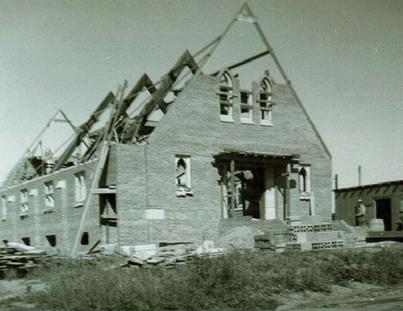

numerous gifts from members of the congregation and friends in the community. Pastor Zenk made a substantial contribution through his acceptance of a nominal salary during these years, at a personal sacrifice to himself and his family.

Over the years, St. Peter ministered to its youth through a Luther League program, numerous outings, camping and conventions. A delegation attended the International Luther League Convention in Miami in 1960. The Luther Leaguers attended the convention in San Antonio, Texas, during the summer of 1982.
In 1963, physical improvements to the church building included the installation of stained glass windows and the addition of a church spire. Records from 1967 showed 148 confirmed members, average weekly attendance of 89, and 200 attended the Children’s Christmas Program. Seventy-five children were enrolled in Sunday School and there were 42 Junior Luther League members. Ruth Circle had 26 members and Esther Circle had 28 members.
St. Peter Lutheran Church celebrated its 100th anniversary in 2017 and continues to minister to its members and the Brunsville community. Services with communion are held every Sunday at 8:30 a.m.



















INGREDIENTS:
8 ounces fusilli or bowtie pasta (regular, whole grain or gluten free will work)
2-3 tablespoons extra virgin olive oil
1 lemon, juiced
1/2 teaspoon sea salt, plus more to taste
Lot of freshly ground salt and pepper
1/4 teaspoon of red pepper flakes
4 ounces crumbled feta or sub goat cheese (about ¾ cup)
2 large ripe peaches, sliced
1 pint cherry tomatoes, halved (I love using heirloom cherry tomatoes for color variety!)
1 cup raw corn off the cob (or you can use thawed frozen corn or canned)
½ medium red onion, thinly sliced
5 ounces baby arugula (about 6 packed cups of arugula)
Optional: Quartered salami and avocado (makes leftovers last longer and adds texture to the salad!)
DIRECTIONS:
Bring a large pot of water to a boil and add a little salt. Once water boils, add the pasta and cook until al dente, about 7-9 minutes. Drain pasta, reserving a few tablespoons of water for later. Place pasta in large bowl.
In a small bowl, whisk together the olive oil, lemon juice, salt, pepper and red pepper flakes until well combined. Pour the dressing over warm pasta and add a little reserved pasta water to help keep the pasta moist and non-sticky. Immediately add feta and gently give the pasta a toss.
Next add in the peach slices, cherry tomatoes, corn, red onion and arugula. Toss to combine. Taste and add more olive oil, lemon juice, salt and/or pepper, if necessary. Great warm or cold. Serves 6.










